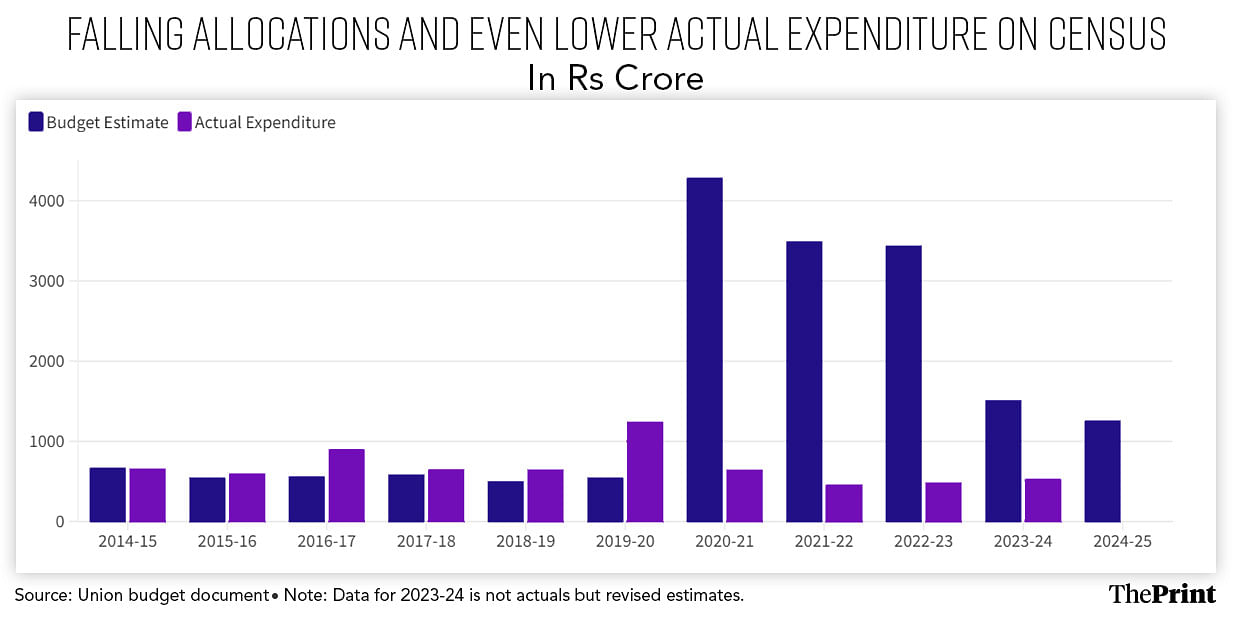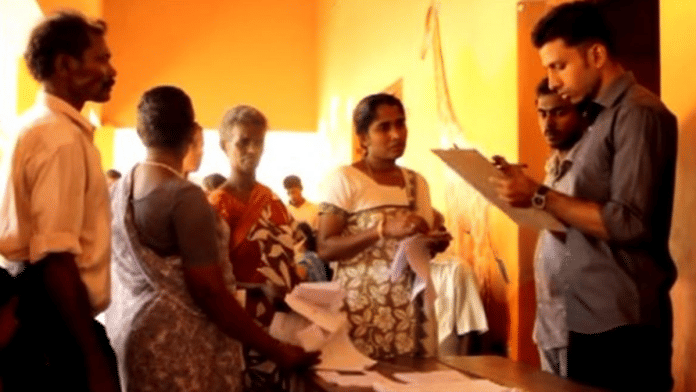New Delhi: The Ministry of Home Affairs has not expressed an intent to go ahead with the national census this year, which is reflected in the fact that the budgetary allocation for the census has been cut for 2024-25 to Rs 1,250 crore, nearly 17 percent lower than last year, and just one-third of what was allocated in 2021-22.
An analysis by ThePrint of past budgets for the national census shows that while the initial allocations have been significantly higher since the pandemic than before it, these numbers have been falling steadily since 2020. Further, even of the amount allocated, only a fraction has actually been spent each year.
“The census is an important piece of estimation for all policymaking,” Seth said in an interview Wednesday. “As and when that decision (to go ahead with the census) is taken, it will be in the public domain and necessary allocations will be made.”
“We don’t anticipate an expenditure and then make a provision (in the budget),” he explained. “The department that is the owner of a particular activity makes a case and seeks allocations.”

The budgetary analysis reveals a clear trend in the government’s intent or lack thereof to carry out the national census. During the 2015-16 to 2019-20 period, the government’s actual spending on the census was more than what it budgeted. Since then, even though the allocations have shot up, the actual spending has languished at those same low levels.
The fact that the national census found no mention in the budget speech or the Economic Survey, despite being vital for effective policymaking and delayed by more than three years, shows that the government has no urgency to complete it, according to economists.
Also read: Modi can’t prove India is 5th largest economy. Data will fail him
Heavy delays, with a cost
The release of the national census was due in 2021, but is still awaited. The government had, at first, cited the COVID-19 pandemic as the reason for the delay, but has since remained silent about the progress.
As a result, policymakers are forced to refer to the 2011 census to design policy for the future.
“It’s not lost on anybody, including the government, that it needs to be done,” Amit Basole, professor of economics and head of the Centre for Sustainable Employment at Azim Premji University, told ThePrint. “So I can only assume that it is not being done for some very good reasons, which may include political reasons. It will happen when they want it to happen.”
Noted statisticians Pronab Sen and Surjit Bhalla had also previously pointed out in an interview with ThePrint that an updated census was crucial for effective policymaking and targeting of welfare measures.
The delay can perhaps be attributed to the fact that the inter-state delimitation exercise can only be carried out based on a census conducted after 2026. Had the census taken place in 2021, then the next one would have been in 2031, which would have delayed the delimitation process, and also the implementation of the women’s reservation law.
Statistical reforms, but no mention of census
“For improving data governance, collection, processing and management of data and statistics, different sectoral databases, including those established under the Digital India mission, will be utilised with active use of technology tools,” finance minister Nirmala Sitharaman said during her budget speech Tuesday.
However, there was no mention of the census in her speech. The Economic Survey 2023-24, tabled in Parliament Monday, also suggested several measures to improve India’s statistical system, but failed to mention the census.
These new suggested measures included providing the Ministry of Statistics and Programme Implementation (MoSPI) with adequate resources, and improving the quality of the data provided by other ministries.
Other suggestions were to increase the timeliness and granularity of data on prices, Goods and Services Tax collections, state and central government finances, production and employment by micro, small and medium enterprises (MSMEs), and deployment of bank credit.
The survey noted that MoSPI, as the nodal ministry for the development of India’s statistical system, had already initiated several steps to improve the country’s data systems. These include starting new nationwide surveys, such as the annual survey of unincorporated sector enterprises (ASUSE), a time-use survey, and a pilot for an annual survey of service sector enterprises.
“MoSPI is also working towards increasing the frequency of PLFS (Periodic Labour Force Survey) data and extending the generation of quarterly estimates for rural areas,” it said. “Modern IT tools are being adopted for improved data capturing and processing.”
Further, it said that in order to encourage greater use of India’s administrative data, a National Metadata Structure is also being developed. A Unified Data Portal project has been envisaged by MoSPI, with the objective of creating a centralised database and storage system, the survey noted.
Also read: Decade without data – Why India is delaying Census when US, UK, China went ahead during Covid
Census crucial for effective policymaking & reforms
Economists ThePrint spoke to said that an updated census was crucial for policymaking — since a lot of our data is based on it — and also an important factor in effectively carrying out even some of the reforms announced in this budget.
“The census definitely plays an important role from a policy perspective,” Samir Kanabar, tax partner at EY India said. “The FM did mention that within six months, there would be a committee that would come up with a report on what policy changes will be required in the Income Tax Act.”
“If the government doesn’t have the census or the data, how are they going to come up with an answer or even fathom what changes they need to make in tax laws?” he asked.
Basole further pointed out that the census is the base database for a number of surveys conducted by the government, which are all currently outdated because the census itself is outdated.
“All of the sample surveys draw on the census frame, which is very old right now, so the sample surveys are suffering because of that,” he explained. “The numbers we have on all the welfare schemes are mostly administrative data, so the census will also tell us the actual reach of these programmes.”
He added that a new census would also allow us to determine the real number of people living below the poverty line or need the ration system.
The government’s Pradhan Mantri Garib Kalyan Anna Yojana, for example, provides free food to 80 crore individuals. However, this 80 crore number is based on an old estimation of how many people actually need this support.
Aditi Nayar, chief economist at ICRA, pointed out that along with the budget, several other metrics also need to be updated as they are very outdated.
“The short answer is yes. The government must get moving on the census, and also on all the other really old data sources that we have which need updation, like the Index of Industrial Production, Consumer Price Index, and the Wholesale Price Index,” she said. “The GDP base is so old, there’s stuff in there that we don’t use any more.”
(Edited by Mannat Chugh)
Also read: GDP to IIP—Indian statistical systems have bigger problems than ‘underestimating’ population






